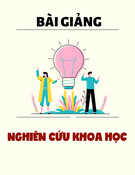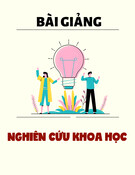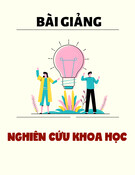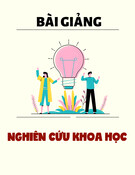
TNU Journal of Science and Technology
229(03): 202 - 209
http://jst.tnu.edu.vn 202 Email: jst@tnu.edu.vn
THE PERCEPTION ON CULTURE AND ITS INTEGRATION PROCESS
INTO THE EDUCATIONAL ENVIRONMENT OF DALAT UNIVERSITY
Nguyen Do Thien Vu*
Da Lat University
ARTICLE INFO
ABSTRACT
Received:
05/01/2024
The present paper aims to explore the conception of culture within higher
education settings in Vietnam. On the one hand, the study investigates the
perception on culture of administration, faculty, staff, and students of
Dalat University. On the other hand, the integration process of culture
into their educational environment has also been studied. The results of
synthesizing and analyzing recent official reports in this field, along with
data from a survey conducted during the academic year 2017-2018 at
Dalat University, indicate that the university has been endeavoring to
foster an academic culture to enhance their cultural profile. Indeed, both
tangible and intangible values constitute essential components of the
university‟s identity. Tangible values encompass material aspects or
various activities visible on campus, while intangible values pertain to the
humanistic and professional aspects of the university‟s community.
However, it appears that academic culture is primarily confined to
institutional principles, often interpreted simply as “Do‟s” and “Don‟ts”,
without fully considering its multidimensional aspects. The author
concludes by providing some insights into this matter as well as raising
some concerns related to the concept in question.
Revised:
22/3/2024
Published:
22/3/2024
KEYWORDS
Academic culture
Culture
Cultural identity
Institutional principles
University‟s profile
QUAN ĐIỂM VỀ VĂN HÓA VÀ TIẾN TRÌNH TÍCH HỢP VĂN HÓA
VÀO MÔI TRƯỜNG GIÁO DỤC CỦA TRƯỜNG ĐẠI HỌC ĐÀ LẠT
Nguyễn Đỗ Thiên Vũ
Trường Đại học Đà Lạt
THÔNG TIN BÀI BÁO
TÓM TẮT
Ngày nhận bài:
05/01/2024
Bài báo nghiên cứu quan niệm về văn hóa trong bối cảnh giáo dục ở
bậc đại học Việt Nam. Một mặt, tác giả tập trung tìm hiểu quan điểm
về văn hóa của đội ngũ quản lý, giảng viên, nhân viên và sinh viên tại
trường Đại học Đà Lạt. Mặt khác, tác giả xem xét tiến trình tích hợp
khái niệm này vào môi trường giáo dục đại học. Kết quả tổng hợp và
phân tích một số báo cáo chính thức liên quan lĩnh vực này, cùng với
dữ liệu khảo sát thu thập được trong năm học 2017-2018 tại Trường
Đại học Đà Lạt cho thấy nhà trường đang hết sức nỗ lực xây dựng văn
hóa học đường nhằm mục đích tôn tạo diện mạo văn hóa của họ. Thật
vậy, cả giá trị vật thể và phi vật thể đều góp phần cấu thành những yếu
tố cốt yếu tạo nên bản sắc của trường đại học. Giá trị vật thể bao gồm
các khía cạnh vật chất hoặc các hoạt động khác nhau có thể nhìn thấy
được trong khuôn viên trường, trong khi giá trị phi vật thể liên quan
đến các khía cạnh nhân văn và chuyên môn của cộng đồng trường đại
học. Tuy nhiên, có vẻ như văn hóa học thuật chủ yếu chỉ giới hạn ở các
nguyên tắc thiết chế, thường được hiểu đơn giản là những gì “Nên
làm” và “Không nên làm” mặc dù nó hàm chứa nhiều khía cạnh. Cuối
cùng, tác giả đưa ra một số nhận định cũng như nêu lên một vài suy
nghĩ về vấn đề nghiên cứu.
Ngày hoàn thiện:
22/3/2024
Ngày đăng:
22/3/2024
TỪ KHÓA
Văn hóa học đường
Văn hóa
Bản sắc văn hóa
Nguyên tắc thiết chế
Diện mạo đại học
DOI: https://doi.org/10.34238/tnu-jst.9548
*Email: vundt@dlu.edu.vn

TNU Journal of Science and Technology
229(03): 202 - 209
http://jst.tnu.edu.vn 203 Email: jst@tnu.edu.vn
1. Introduction
One of the biggest concerns of human beings is culture. This key concept has been defined by
UNESCO as follows: “Culture should be regarded as the set of distinctive spiritual, material,
intellectual and emotional features of society or a social group, and that it encompasses, in addition
to art and literature, lifestyles, ways of living together, value systems, traditions and beliefs” [1].
Culture therefore constitutes an essential part of human life and an inherent part of all
educational systems. In a broad sense, the concept of culture can be grasped as “the patterns
shaped by ethnicity, religion, socio-economic status, geography, profession, ideology, gender,
and lifestyle” [2]. For their part, anthropologists argue that culture encompasses abstract elements
such as shared beliefs, values and ideologies; whereas, partisans of cognitive development theory
offer their own definitions. Saville-Troike [3] considers culture as what the individual needs to
know to be a functional member of the community. Thus, human behaviors can reflect people‟s
culture. Alternatively, culture can also be seen as a means of the preserving and spreading human
knowledge and achievements.
Some authors approached this concept through three organizational perspectives: i) an
integrated perspective examining beliefs and values that are common to all organizational
members; ii) a differentiated perspective considering beliefs and values of the existing
subcultures which may contrast or conflict with those of other subcultures or with the general
organizational culture; iii) a fragmented perspective considering organizational members‟ views
to be ever changing with few shared understandings [4].
Hence, culture generally plays an important part in education, particularly in higher education.
Studying academic culture of universities, Shen and Tian [5] argued that culture consists of four
main components including academic outlooks, academic spirits, academic ethics and academic
environments. These authors contended that academic culture is reflected in common values,
spirits, and behavior norms of teachers and learners. University is indeed an existing form of
culture on campus where material culture, institutional culture and spiritual culture constitute
three major factors contributing to raising the university‟s profile at large. They also advocated
the idea that “campus culture in a university is characterized by individuality, academic feature,
opening, leading, variety and creativity” [5].
Additionally, Chavez has divided the notion „culture‟ into three main components:
“practices, products, and perspectives” and “what we understand by culture has important
implications for subsequent pedagogical decisions” [6]. She considered the formula of foreign
language culture as a combination of custom and history, and language. However, the
importance of culture has been differently perceived by teachers and learners. In general, the
definitions of culture may vary by nation.
In Vietnam, some authors have pointed out that Confucianism still has an important influence
on the education of our country. In fact, Confucian principles are manifested in social order and
the self-improvement [7]; and the educational system is characterized by a system of virtues and
values rooted in traditions [8]. Vietnam is a typical Confucian heritage culture country where the
respect of the elderly and high-rank persons and the obedience of children still value. Rooted in
Confucianism, Vietnamese culture may not easily or entirely incorporate foreign culture into its
own. So far, Vietnam has actually undergone significant transformations in the realms of
education, economics, politics, and society. These changes undeniably play a crucial role in
shaping cultural dynamics [9].
Other Vietnamese researchers have stressed on cultural values that should be placed on par
with economy, politics and society [10]. In their opinion, culture should be transformed into the
soft power of our country, especially within the context of globalization and international
integration. Cultural promoters, including authorities in charge of culture as well as educators, are
supposed to maintain traditional cultural values and help enhance cultural identity amongst the

TNU Journal of Science and Technology
229(03): 202 - 209
http://jst.tnu.edu.vn 204 Email: jst@tnu.edu.vn
Vietnamese people. At the same time, they should help our culture absorb new beliefs and values
emanating from democracy, modernity, humanity, liberalization, tolerance, and broadness. As a
matter of fact, these values are becoming apparent in higher education. Besides, the study related
to academic culture of Pham [11] only highlighted a dozen offenses which are committed at a
high average rate due to both subjective causes and objective causes. The subjective causes refer
to students‟ consciousness, and input quality, whereas the objective causes pertain to limited
effectiveness of family education and previous middle school education, current insufficient
effectiveness of education at universities, and impact of the external environment, as well as the
influence of international cultures, as mentioned in [12].
In this regard, our research aims to explore additional dimensions of the concept of culture,
specifically focusing on Dalat University‟s perception of this concept and its integration into our
educational environment. In the context of competition within higher education institutions, we
hope that this paper provides insight into the importance of integrating the concept of culture in
shaping our university‟s profile.
2. Methodology
To address these issues, the current research first aims to shed light on the subject by
synthesizing and analyzing recent official reports on the overall evaluation of the educational
environment at Dalat University (DLU) using a quantitative approach. Second, a questionnaire
containing 36 close-ended questions and two open-ended questions was administered to gather
the feedback from 496 faculty and staff members, along with all 775 senior students from the
K38 classes (academic year 2017-2018) of DLU, prior to their graduation. Taking into account
the distinctive features of its setting, the questionnaire was custom-tailored for DLU, recognized
as one of the prestigious higher education institutions in the Central Highlands of Vietnam and
celebrated for its unique identity and culture.
In the scope of this paper, the author endeavors to comprehend DLU‟s perception of culture
by examining the institutional and cultural framework outlined by the Ministry of Education and
Training of Vietnam (MOET). The focus of this paper is also directed towards the integration of
this concept into the DLU environment with the aim of shaping their cultural profile. To achieve
this goal, the current paper addresses the following questions:
1. What is DLU‟s perception of the concept of culture?
2. How is this concept integrated into their educational environment?
3. Findings and discussion
3.1. The perception on culture in educational settings
In this section, the thoughts on the perception and integration of culture into educational
settings are presented. Here, the elements related to both material and spiritual aspects of culture
are brought together for a discussion. On one hand, the concept of „culture‟ involves compliance
with institutional principles, while on the other hand, its integration into educational settings
undeniably contributes to the overall development of institutions and the construction of their
cultural profile.
Shen and Tian [5] revealed that, on the one hand, the academic culture is able to enhance the
construction of campus culture; on the other, the campus culture conditions and restricts the
academic culture development. It is suggested that the cause-and-effect relationship does exist
between academic culture and campus culture.
Based upon the Constitution of Vietnam, the Law on education primarily stresses on people‟s
morality and intellectuality. Precisely, Article 35 of the Constitution of Vietnam states that
“education‟s objective is to foster and nurture the personality, human qualities and imbue with
…. good virtues…” [8]. In other words, the educational goals are to form good citizens having
virtues, knowledge, and skills so that they will be able to contribute to the overall development of

TNU Journal of Science and Technology
229(03): 202 - 209
http://jst.tnu.edu.vn 205 Email: jst@tnu.edu.vn
the country. Indeed, the education of moral values has precisely been stipulated and set by law.
Precisely, the 2019 Law on education prescribes the goals of education in Article 2 as follows:
The goals of education are to develop the Vietnamese in a comprehensive manner into
cultured persons who have good moral qualities, knowledge, good health, aesthetic sense, and
occupational skills; civic virtues, competencies and consciousness; and patriotism, sense of
national spirit and loyalty to the ideology of national independence and socialism; to promote
potential and creativity of each individual; and to raise people‟s intellectual standards, develop
human resources, nurture talents and meet requirements of the cause of national construction and
defense and international integration.
In addition to this, the requirements of instructional content and methodologies are clearly
stated in Article 7 implying that the teaching and learning content needs to inherit and promote
tradition, cultural identity as well as absorb the cultural quintessence of mankind; whereas
teaching methods should focus intensively on learner‟s autonomy and capability of cooperation
and practice. Besides, a number of acts prohibited in educational institutions are stipulated in
Article 22. Another important point is that the State is determined to help foster research and
technology activities to establish institutions of higher education as centres for culture, science
and technology at different levels.
Given the above information found in legal texts, culture plays a key role in developing the
national education. Graduates should be professionally qualified and, to some extent, culturally
evaluated. It is likely that cultured people make life better. To be more precise, an experienced
teacher ought to have a good moral that is often manifested in his devotion to his students. A
competent learner also needs to have good attitudes towards his or her learning and show respect
to the others. In brief, the cultural aspects have been considered a goal to reach in the educational
system of the country.
Pham Minh Hac [11] defined school culture as a system of standards and values that help
school administrators, teachers, parents and students have a good way of thinking, feeling and
behaving. The cultural behavior within educational institutions is basically associated with moral
and aesthetic standards that regulate people‟s behavior manifested in attitudes, utterances,
gestures and acts, and so forth [13].
3.2. The integration of culture into DLU environment
3.2.1. With regard to administration, faculty, staff
The promulgation of the Regulations on DLU‟s campus culture dated August 16, 2021 takes
on a significant importance of the cultural component within the university. In this regard, the
administration, faculty, and staff are required to abide by the standards of conduct and behavior
in compliance with the ministerial regulations. These latest Regulations stipulate in chapter I a
number of “Do‟s” and “Don‟t”, that shall be applied to all people on campus, pertaining to spirit,
professional attitude, communication and behavior criteria, moral virtues, lifestyle, outfit, campus
configuration. In this manner, the goals are to 1) raise the awareness of organizational discipline,
and ensure the solemnity and effectiveness of all units on campus; 2) build standards of behavior
among all people working on campus, and develop the good virtues amongst them; 3) serve to
evaluate and rank administration, faculty, and staff on an annual basis, and reward or penalize
according to their performance or offence in relation to professional achievement and community
relationship. Also, people are also informed of six acts that are banned on and off campus such as
smoking in the office; gambling and organizing gambling, and get involved in social problems;
having alcoholic drinks during working hours and lunch break (except guest reception authorized
by officials according to diplomatic protocol); performing personal business or disturbing the
others; using earphones, watching movies, playing video games and having other leisure
activities during working hours; being superstitious and having offensive behaviors attending
traditional festivals and cultural events. In chapter II, the required professional spirit and attitudes

TNU Journal of Science and Technology
229(03): 202 - 209
http://jst.tnu.edu.vn 206 Email: jst@tnu.edu.vn
are described in details in Article 5; the communication and behavior norms in Article 6; the
standards of communication and behavior with learners and professional visitors in Article 7; the
standards of communication via telephone and other devices in Article 8; the standards of
conduct in meetings and conferences in Article 9; the standards of lifestyles, moral and ethical
conduct at workplace in Article 10; the requirements of outfit and dress uniform in Article 11.
The chapter III is devoted to office decoration in which are stipulated the instructions on flag
hanging (Article 12), institution‟s signboard (Article 13), working offices (Article 14), offices
surroundings (Article 15), and vehicle management (Article 16).
Furthermore, within the scope of this paper, the author presents pertinent findings derived
from recent reports based on surveys conducted at DLU. These surveys employed a 5-point
Likert scale. The annual internal report of 2017-2018 revealed positive results provided by more
than 400 faculty and staff members pertaining to “the overall evaluation of the educational
environment”. Below are the questionnaire results, which exclusively concentrate on pertinent
questions regarding cultural aspects perceived within our educational settings and demonstrating
a high level of agreement (levels 4 and 5: agree and totally agree):
● Question 1: 86.1% of faculty confirmed that they “love their job at DLU”;
● Question 2: 82.4% of them felt “proud to work for DLU”;
● Questions 1-4: over 80% of them found their “colleagues to be friendly, sociable, open-
minded, professional, and helpful”.
Similarly, a survey conducted amongst DLU graduates showed better results as follows:
● Question 22: 90.8% of the respondents agree or totally agree that “the learning settings and
the environment are favorable for their studies”;
● Question 38: 89.5% of them agree or totally agree with the “quality of living and studying
environment”.
In that same year, DLU undergraduates participated in another survey concerning the
assessment of faculty provided satisfactory results:
● Question 20: 94.8% of the participants agree or totally agree that “faculty‟s outfit and
styles are appropriate and polite”;
● Question 23: 94.1% of them agree or totally agree with “faculty‟s proper behavior and
respectful attitude towards students”.
In addition to this, it is important to notice that DLU faculty has been found to be inspiring
and devoted to their teaching career.
Despite these promising results, the reports repeatedly indicate that the collegial relationship
needs to be tighten through various sportive and cultural events. The university should create more
opportunities for faculties and staff to work together as well as to develop their friendship and
colleagueship. Lecturers are also asked to stimulate students‟ motivation. Besides, they are
encouraged and required to do research. Such a finding is quite more encouraging in comparison
with that of [10], [11]. However, more thorough studies within a longer period from five to ten years
should be conducted in order to provide a fuller, and especially more credible, picture in this matter.
Additionally, a number of drawbacks have been revealed related to teaching methodologies
that need to be updated and concentrate on groupwork more in more intensively. It is requested
that the university pay more attention to maintenance of on-campus facilities; cleanliness and
tidiness; stability of the university‟s portal; rationality of course schedule, motorbike parking
spaces, and classroom arrangement; reinforcement of dormitory security, and the like. It is
important to notice that the Department of Student Affairs urges the university to implement
strict measures on students who often play truant and those who have poor academic performance
because, in their opinion, these affect negatively the university‟s profile. The inappropriate
behavior manifested in lack of effective communicative skills, unprofessional attitude and rude
words of some administrative staff has also been alerted.


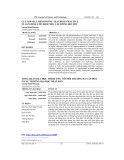
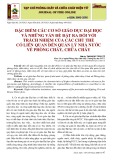
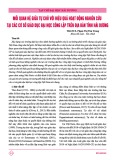
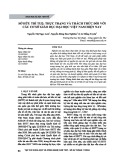
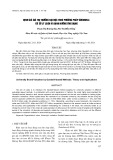

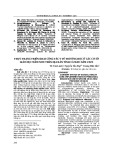
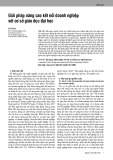






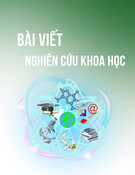

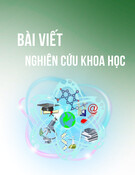


![Định hướng giáo dục STEM trong trường trung học: Tài liệu [chuẩn/mới nhất]](https://cdn.tailieu.vn/images/document/thumbnail/2025/20251124/dbui65015@gmail.com/135x160/25561764038505.jpg)
